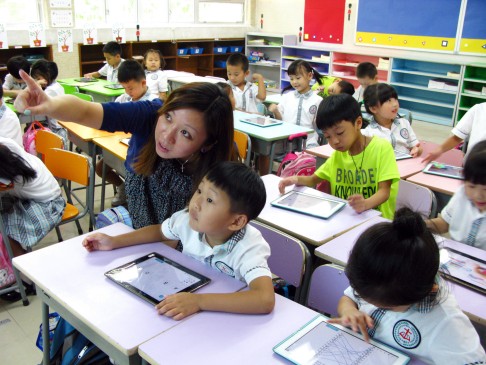
Public schools lack funds to implement digital teaching methods
Slow internet access and lack of resources mean some schools left behind
Children today are no strangers to digital learning. At Baptist Rainbow Primary School in Wong Tai Sin, tablet computers are even a fixture in Primary One classes.
Doing alphabet matching exercises on iPads has become a routine, with teachers picking and displaying answers on a big screen in the classroom to help students learn.
The school of about 190 students has its own online learning platform, 80 tablet computers, a digital library of more than 8,000 e-books and a room dedicated to three-dimensional printing.
Upper primary students are learning app design as well as aerial photography for capturing city footage in general education classes. The school is also preparing for a series of new initiatives, including a flipped classroom whereby students first watch digitally recorded lectures at home, then discuss them with their peers and teachers online before doing presentations in class.
All these efforts are intended to nurture tech-savvy graduates for the future workforce.
"Creativity will be very important 20 years from now," principal Chu Tsz-wing says.
"The world will be so different. So we cannot use the same mechanical teaching methods that were used before. In the past, it was often about jotting down facts in class. Now it is about sharing, communication and fostering creativity. The students have a high degree of autonomy."
However, it is rare among schools in grass-roots areas of Hong Kong to offer the same degree of digital learning, despite the perceived benefits of learning at one's own pace.
For example, the teachers and 300 students at Shan Tsui Public School in Sha Tau Kok, have long endured slow internet connection. It took the school several years to save HK$100,000 from its government funding to pay for a network upgrade.
"Most e-books are tailor-made for tablet computers," principal Leung Chi-man says.
"Also, in some cases, e-learning materials are available on the publisher's servers, for which you need a fast internet connection."
Most students at the school are from low-income local families or mainland families who live over the border. Their homes are often equipped with poor computer and internet facilities.
Mainland students, who have a long journey to school each day, cannot access across the border some Hong Kong news websites and search engines that their local counterparts find useful.
E-learning allows teachers to incorporate the most up-to-date materials into their teaching. Yet at Fresh Fish Traders' School in Tai Kok Tsui, that is possible only for the subjects of Chinese, English and mathematics.
Principal Leung Kee-cheong says: "We still do not have a wireless network for the entire school, and we have a computer room with only 40 consoles. We are quite behind in developing digital learning."
Chan Hung, a former school principal now offering free tuition classes for children from impoverished families, laments that many of these children are lagging behind due to lack of resources.
"It is not just a money problem. Even if they have a donated computer at home, they might have to share it with their parents and siblings. Or they can only use it in crammed spaces.
Teachers need to learn how to enhance interactivity in the classroom
"In some cases, the parents are unable to install the right software. Some homes do not have a high-speed internet connection," Chan says
These children often rely on computers in public libraries and feel inferior to students whose families are better resourced, he adds.
He calls on community organisations to set up learning centres equipped with computers and wireless network for children from impoverished families after school. Better-equipped schools may also open up their facilities to children living in the neighbourhood.
Besides community resources, high quality e-books as well as teacher training are also important.
"Currently, most e-books are just duplications of print textbooks," Chan says.
"Teachers should be given more time to incorporate up-to-date information such as current issues into learning materials; they also need to learn how to enhance interactivity in class."
Since 2011, the government has run the I Learn at Home scheme to subsidise internet access and computer training for underprivileged families.
Organisations such as WebOrganic, run by the social enterprise Internet Learning Resource Centre, and the Boys' and Girls' Association of Hong Kong have been roped in to implement the programme in Eastern and Western districts on Hong Kong Island. Under-resourced schools face a tough challenge to catch up with the digital trend.

At Baptist Rainbow Primary School, rather than handing out paper worksheets, teachers have started to distribute and mark them online. Model student work is shared electronically with the whole class.
Principal Chu says he plans to change the layout of classrooms so that desks are arranged in small circles rather than rows, and where students can freely write on glass walls. There will be no designated teacher's desk.
"[To get started], teachers can film the highlights of their teaching using their own phones for the students to watch at home. School life will become more interactive and about doing projects," he says.
New inventions keep arriving on the scene. One example is Classcraft, a Canada-based online educational platform that enables students to role-play and acquire scores through achieving tasks designed by their teachers.
Teachers in 50 countries have already signed up, and a traditional Chinese version will be launched soon.
Its founder, teacher Shawn Young, says that the gaming element adds a new layer on top of traditional teaching. "It allows the game to go beyond the four walls of the classroom," he says.
"Students earn and lose experience points for performance inside and outside the classroom, and interact with each other online."
